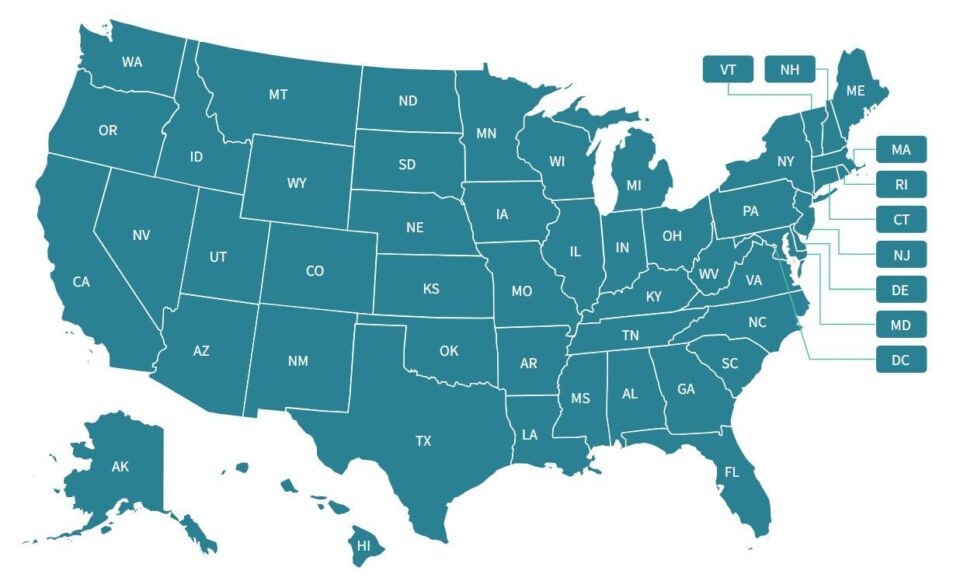The State Energy & Environmental Impact Center studies and supports the work of state attorneys general in defending, enforcing, and promoting strong laws and policies in the areas of climate, environmental justice, environmental protection, and clean energy. But what exactly is a state attorney general, and what do they do?

Intro
Each state and territory in the United States has its own lawyer who represents both the state or territorial government and the public. These lawyers have a variety of responsibilities and powers, which include advising, defending, and bringing actions on behalf of state agencies; enforcing state laws; and serving the public’s interest. These lawyers are—you guessed it!—state attorneys general.
The role of a state attorney general is unique for a few reasons.
The primary role of an AG is to represent state agencies in court. But the powers of an AG can and often do extend beyond this role: AGs take many different actions to protect and represent the people of the state, which empowers AGs to respond nimbly as administrations change and issues evolve. The Center’s “A Role for State Attorneys General in a Just Transition” report provides an illustration of this by identifying how AG tools like enforcement, public education, and advocacy can be used to help promote a more just transition as the energy sector moves towards clean energy and away from fossil fuels.
Additionally, AG authorities vary considerably by state or territory.
Each AG has a staff that makes up the state’s Office of Attorney General—abbreviated as OAG or AGO, and sometimes called the Department of Justice (DOJ) or Department of Law (DOL). In addition to lawyers, who usually have a title of “Assistant Attorney General” (AAG), an AG’s office may also include economists, scientists, librarians, communications professionals, and other non-lawyer positions. This video by former Maine AG Jim Tierney describes the structure of an AG’s office.
Who is my AG?
From the National Association of Attorneys General, a nonpartisan national forum providing collaboration, insight and expertise to empower and champion America’s AGs
Nuts & Bolts
So how do AGs get into office? This, and many other parameters of the office, vary by state. Most AGs are elected by the general public. A handful are appointed by the governor (see this paper for a deep dive on the relationship between state AGs and governors), or selected by another state body. Most AGs serve a term of 4 years, though some states’ terms are as short as 2 years. Limits on the number of terms an AG can serve also vary, with some states limiting by total terms, some by consecutive, but most not limiting the number of terms at all.
- Attorney general is often abbreviated as “AG”
- The plural of attorney general is “attorneys general”
How do AGs get in office?
- Elected
All but those listed below
- Appointed by the governor
Alaska, Hawaii, New Hampshire, New Jersey, Wyoming, American Samoa, Puerto Rico, U.S. Virgin Islands
- Selected by secret ballot of the legislature
Maine
- Selected by the State Supreme Court
Tennessee
How long is an AG’s term?
- 4-year term
All but those listed below
- 2-year term
Maine, Vermont
- 8-year term
Tennessee
- No term length specified (but AGs are appointed by the governor)
Alaska, Hawaii, New Jersey, Wyoming, American Samoa, Puerto Rico, U.S. Virgin Islands
Are there term limits?
- No fixed term limit
All but those listed below
- 2 total terms
Arizona, California, Florida, Michigan, Montana, Nevada, Pennsylvania
- 2 consecutive terms
Alabama, Arizona, Colorado, Kentucky, New Mexico, Ohio, Rhode Island, South Dakota
- 4 consecutive terms
Maine
What are the eligibility requirements?
The rules around who is eligible to become AG—including requirements for residency length, age, and bar admission—vary by state. See NAAG’s Attorney General Office Characteristics resource for more information.
Source: “Attorney General Office Characteristics” from the National Association of Attorneys General
AG Powers

AGs have a wide variety of tools that they can use to protect and defend both the people and the state. Our AG Actions Database gives a good sampling of actions AGs have taken in the areas of climate, clean energy, and the environment.
Law Enforcement
One of the primary roles of an AG is to enforce the law. They often do this through filing lawsuits or taking other enforcement actions against companies and individuals that violate the law. Though AGs do some criminal enforcement and prosecution work, most states limit their AG’s criminal jurisdiction, so AGs typically focus on civil matters.1
Representing the Public
An AG—sometimes referred to as the “people’s lawyer”—represents the public’s interest. At the state level, they do so through affirmative actions such as participating in state administrative proceedings, providing testimony at hearings, proposing legislation, and launching investigations. They also do this federally, by engaging in rulemaking processes at federal agencies, sending letters to Congress, testifying at hearings, and more. AGs also keep the government in check, suing federal or even state agencies when they violate the law or exceed their authority, which in turn protects the public. At both levels, AGs have a fairly broad set of policy and legislative advocacy tools that can adapt to the challenges and opportunities presented by any particular circumstances.
Representing the State
AGs also represent and serve the government. They advise state agencies, represent and defend the state in court, and issue legal opinions clarifying and answering questions about state laws.
Other Powers
AGs also have a variety of soft powers that come with their position as public figures with a platform, connections, and influence. Filtering for “other” action types in our AG Actions Database gives a sense of the different ways AGs can be creative in using their powers to enforce existing laws and leverage change. To name a few examples from the climate and clean energy space, AGs have:
launched initiatives to bolster public participation;
awarded grants for environmental projects;
issued reports on energy market challenges;
launched public education campaigns on issues such as illegal idling and the dangers of asbestos;
set up consumer protection hotlines related to environmental disasters and misconduct;
sent letters to companies encouraging compliance with state environmental laws;
written op-eds on pressing climate and environmental justice issues;
created task forces on topics like extreme heat and energy justice;
and much more.
To stay up to date on the latest environmental and energy related actions by state attorneys general, subscribe to Legally Speaking, the State Impact Center’s bi-monthly newsletter, and sign up to be notified about our events, where you can hear from AGs and AG staff about the work that they do.
Resources and Reading
AG Actions Database
We maintain a database of administrative, rulemaking, and legislative actions taken by attorneys general that involve clean energy, climate change and environmental interests of regional and national significance since 2017.

A Role for State Attorneys General in a Just Transition
Our 2022 report provides insight into the role of AGs, highlights recent AG enforcement of workers’ rights and environmental protection, and offers additional ideas for what state attorneys general can do in relation to a just transition.

State Attorneys General: Empowering the Clean Energy Future
Our 2019 report explores how AGs have utilized federal and state energy law principles across different forums to ensure that clean energy innovators have expanded opportunities to participate fully and fairly in electricity markets.

The Health & Environmental Settlements Project
The Center’s Settlements Project provides a comprehensive, independent analysis of prior judicial and legislative settlement structures, both successful and not, by evaluating mechanisms that have been used by state AGs, Congress, and others to address the toughest large-scale health and environmental liability and compensation challenges over the last 50 years.

National Association of Attorneys General’s Website
The National Association of Attorneys General (NAAG)—a nonpartisan national forum providing collaboration, insight and expertise to empower and champion America’s AGs—provides up-to-date, in depth information about AGs.

Multistate Litigation Database
This database, hosted on the State Litigation and AG Activity Database website, was created and is maintained by Dr. Paul Nolette, Associate Professor of Political Science at Marquette University.

State Attorneys General Project
This project by the American Constitution Society (ACS) offers legal resources and events examining the actions of AGs and the emerging legal and policy issues they face. And check out this episode of ACS’ podcast: A State Attorney General Does What Exactly?

State AG Pulse — A Podcast by The State AG Report
State AG Pulse is a weekly podcast produced by The State AG Report, a practice group at Cozen O’Connor dedicated to representing clients in AG investigations and litigation, and counseling clients on state AG matters.

Leadership Center for Attorney General Studies
The Leadership Center for AG Studies focuses on the work of Attorneys General and the impact their offices have on communities. By conducting original research, analyzing AG actions, and communicating this knowledge to key stakeholders and the public, the Leadership Center hopes to create a better informed public on the importance of Attorneys General.

StateAG.org
An online educational resource on the office of state attorney general created by former Maine AG Jim Tierney, the former director of the National State Attorneys General Program at Columbia Law School.
Career Opportunities
Interested in opportunities at AG offices, or in a career in public service? Check out our Student Connections page, which features events, resources, career opportunities, and more for those interested in climate, clean energy, environmental justice, and environmental careers.
Written by Tiernaur Anderson, Senior Communications & Digital Specialist. Last updated August 8, 2023.
- The criminal jurisdiction of each AG office varies. See Chapter 17 of NAAG’s State Attorneys General Powers and Responsibilities for more details.
